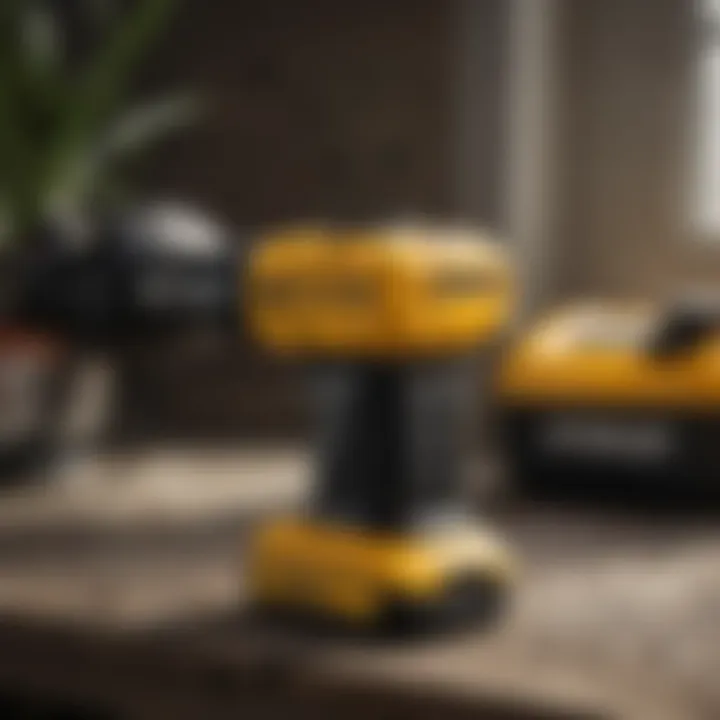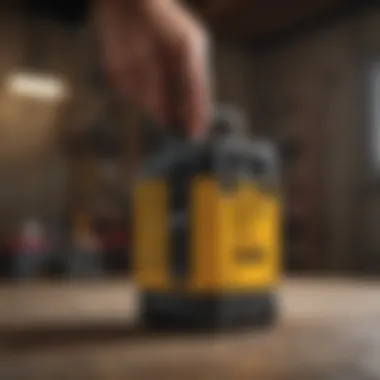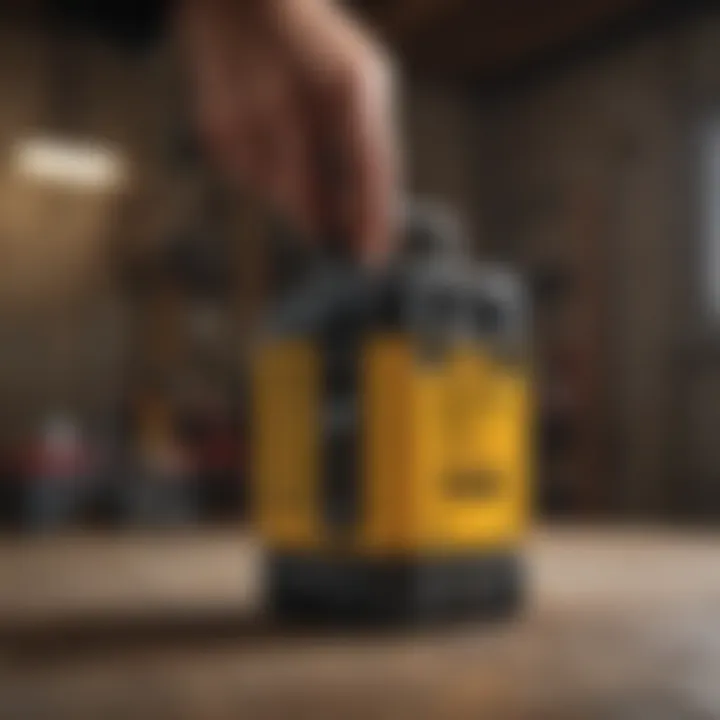Understanding Dewalt Cordless Weed Eater Batteries


Intro
The Dewalt cordless weed eater battery has become a staple in home improvement due to its performance and convenience. As gardening and landscaping take a firm root in home care routines, understanding the specifics of the tools used is vital. The importance of selecting the right battery cannot be overstated, as it directly influences efficiency and ease of use.
In this guide, we’ll explore the nuances of Dewalt cordless weed eater batteries. We’ll cover essential specifications, compatibility with various models, and practical maintenance practices. Armed with this knowledge, homeowners can make informed choices, ensuring their gardening tasks are executed efficiently and effectively. It will empower users to not just purchase a tool but to select a reliable partner for their outdoor tasks.
Preface to Cordless Weed Eaters
Cordless weed eaters have become a vital tool in lawn care and garden maintenance, offering a level of convenience and efficiency that traditional gas-powered string trimmers cannot match. In this section, we will explore the critical elements of cordless weed eaters, focusing on their definition, functionality, and the advantages they provide to homeowners and gardening enthusiasts.
Definition and Functionality
A cordless weed eater, also known as a string trimmer, is a garden tool powered by rechargeable batteries instead of gas or direct electric connections. This design allows for greater mobility and ease of use. You can navigate through your garden without being tethered to a power source. Cordless weed eaters are typically equipped with a rotating head that holds a spool of line, used to trim grass, weeds, and other unwanted foliage. The cutting motion is created by the line spinning at high speeds, which efficiently cuts through plant material.
"Cordless weed eaters make yard maintenance accessible and efficient, particularly in areas where maneuverability is key."
These tools are designed for versatility and comfort. They weigh significantly less than their gas counterparts, making them easier to handle over extended periods. Moreover, many models come with adjustable shafts and handles, allowing for a personalized fit, which is crucial in avoiding strain during usage.
Advantages of Cordless Models
The cordless design presents several benefits:
- Ease of Use: No need to mix fuel or deal with cords.
- Reduced Noise: Operating quietly compared to gas models, which is favorable in residential areas.
- Less Maintenance: Fewer mechanical parts mean less upkeep.
- Lightweight and Portable: Easy to transport and store, especially for homeowners with limited storage space.
These advantages make cordless weed eaters increasingly popular among homeowners. As you consider investing in one, understanding these aspects helps in making an informed decision.
Overview of Dewalt Brand
Dewalt is a significant player in the power tool market, well-known for its durable and efficient products. The brand has cultivated a reputation based on reliability, innovation, and high performance. For homeowners and those who manage their own landscaping, knowing the Dewalt brand is essential. Their cordless weed eater batteries represent not only a tool but an investment into easier and more effective yard maintainance.
History and Reputation
Dewalt was founded in 1924 by Raymond E. Dewalt, who created the first radial arm saw. Since then, the brand has evolved significantly. Today, Dewalt is a subsidiary of Stanley Black & Decker. Its reputation is bolstered by a long history of commitment to quality. Dewalt tools are designed for both professionals and the casual user, offering a blend of potency and versatility.
Customers recognize Dewalt for its customer support and high-performance products. Their tools often endure rigorous usage without significant wear, promoting longevity. This trust in the brand makes Dewalt batteries a go-to choice for many when selecting equipment for yard care.
Product Range
Dewalt offers a comprehensive range of products suitable for various needs. Their product lineup includes handheld power tools, construction equipment, and, notably, outdoor solutions like cordless weed eaters.
The batteries are compatible with many models, which enhances their functionality across multiple devices. This compatibility saves the user money and maximizes usability. Furthermore, Dewalt focuses on providing powerful batteries with impressive lifespans.
Some key features include:
- High-capacity lithium-ion batteries
- Fast charging capabilities
- Extensive compatibility with other Dewalt tools
Dewalt’s commitment to innovation leads them to constantly develop their battery technology, meeting growing demand for effective and efficient outdoor tools.
Technical Specifications of Dewalt Cordless Weed Eater Battery
Understanding the technical specifications of Dewalt cordless weed eater batteries is crucial. These specifications not only dictate the performance of the tool but also its longevity and efficiency. Knowing the specifics can enhance user experience and guide informed choices when purchasing or maintaining these batteries.
Battery Chemistry
Battery chemistry refers to the materials and reactions that power the battery. Dewalt uses lithium-ion technology in their cordless weed eater batteries. This choice is significant because lithium-ion batteries have several advantages over other types, like nickel-cadmium or lead-acid batteries.
Lithium-ion batteries are known for their high energy density. This means they can store more energy in a smaller space, making them lighter and providing users with a more manageable tool. Furthermore, they have lower self-discharge rates, which leads to longer usable life when stored. Importantly, they do not have a memory effect, allowing them to be recharged at any time without affecting their capacity.
Voltage and Capacity Ratings
Voltage and capacity ratings are key indicators of a battery's performance. Dewalt batteries typically come in various voltage ratings, including 20V and 60V options, catering to different power needs. The voltage of a battery represents the potential power it can deliver, which directly influences cutting performance in yard work. Higher voltage batteries tend to provide greater power, making them suitable for more demanding tasks.
Capacity, measured in amp-hours (Ah), represents how much energy the battery can store. A higher Ah rating translates into longer runtime. For example, a 5.0 Ah battery can provide power for a longer duration compared to a 2.0 Ah battery under similar load conditions.


In practical terms, selecting the right voltage and capacity for a specific job is essential. Homeowners should evaluate their yard size and type of vegetation. For larger areas with tougher weeds, opting for higher voltage and capacity will be beneficial.
In summary, understanding the battery chemistry and voltage/capacity ratings can significantly affect the efficiency and longevity of your Dewalt cordless weed eater. This knowledge empowers users to make informed decisions, better tailoring their choices to suit specific needs.
Performance Analysis
Performance analysis is crucial when considering the efficiency and effectiveness of the Dewalt cordless weed eater battery. It involves evaluating several factors that can impact the overall user experience. Understanding these aspects can lead to more informed purchasing decisions and enhance satisfaction with the product.
When discussing performance, two specific elements deserve attention: cutting power and efficiency, as well as runtime and recharge time. Both these components play a significant role in how well the battery operates in real-world conditions. If users are not aware of these factors, they may underestimate the performance metrics that can make or break their experience.
Cutting Power and Efficiency
Cutting power refers to the ability of the weed eater to effectively cut through various types of grass and weeds. A battery's performance in this area directly correlates with the weed eater's motor strength and the design of the cutting equipment. Dewalt cordless weed eaters generally exhibit strong cutting power. This advantage allows them to tackle thicker grass and tougher weeds, which is essential for homeowners who want a tidy lawn.
Efficiency, on the other hand, considers how well the battery utilizes its charge to deliver performance. High efficiency means the weed eater can operate longer without compromising cutting ability. When combined with a well-designed battery, it results in more productive mowing sessions.
Here are a few key points to note:
- High Torque: The electric motors in Dewalt weed eaters are engineered for high torque, which provides better cutting power.
- Blade Technology: The quality of the blades also contributes significantly. Razor-sharp, durable blades reduce resistance and increase effectiveness.
- User Experience: Homeowners regularly note that a powerful battery enables them to finish their yard work quicker, leading to enhanced satisfaction.
"The cutting power of my Dewalt weed eater is impressive. It handles everything I throw at it without losing steam."
These features underscore the importance of selecting a battery that's engineered for performance, enabling users to maintain their lawns efficiently.
Runtime and Recharge Time
Runtime is the duration a battery can support the weed eater before needing a recharge. The longer the runtime, the more versatile the tool becomes for yard maintenance. Dewalt batteries are praised for their substantial runtime, allowing homeowners to complete larger tasks without interruptions.
Recharge time is another important aspect to consider. It indicates how quickly users can get back to work after the battery has been depleted. Dewalt's advanced technology minimizes downtime, which is a critical factor for users managing extensive outdoor tasks.
Here are some insights into runtime and recharge times:
- Run Times Depend on Conditions: The actual runtime can vary based on factors such as grass thickness and the operator's cutting speed.
- Fast Charging: Dewalt's rapid charging capabilities mean users can recharge batteries in less time, enhancing convenience.
- Lifestyle Compatibility: Homeowners with busy schedules can particularly benefit from longer runtimes and shorter charging periods, allowing for more efficient use of time.
Overall, careful considerations of cutting power, efficiency, runtime, and recharge times are key elements in evaluating the performance of Dewalt cordless weed eater batteries. These factors contribute significantly to the success of lawn care practices for house owners and housewives alike.
Compatibility with Dewalt Models
Understanding compatibility when it comes to Dewalt cordless weed eater batteries is crucial for both functionality and overall user experience. Proper compatibility ensures that users do not face performance issues that may arise from mismatched equipment. Considering that Dewalt has a wide range of models, knowing which batteries work best with each model can lead to effective maintenance and greater satisfaction with the tool's performance.
When selecting a battery, it's essential to consider the specific model of the weed eater, as each one may have unique requirements related to voltage and capacity. Therefore, confirming compatibility can prevent potential damage to the equipment and prolong the lifespan of both the battery and the tool. Additionally, using recommended batteries means users can fully exploit the intended efficiency and cutting power that Dewalt designs into their products.
Compatible Weed Eater Models
Dewalt's range of cordless weed eaters, such as the Dewalt DCST920P1 and the Dewalt DCST970X1, rely on compatible batteries to function optimally. These models are specifically engineered to work seamlessly with Dewalt's 20V MAX batteries, enhancing performance through efficient energy conversion.
- Dewalt DCST920P1: Uses a 20V MAX 5Ah Lithium-Ion battery.
- Dewalt DCST970X1: Compatible with 20V MAX batteries, offering various Ah options for different power needs.
- Dewalt DCST972X1: Also utilizes a similar battery system.
It is worthwhile to note that the selection of the right battery capacity will affect not just runtime but also cutting performance. Opting for a lower Ah battery may result in shorter usage time, thus affecting the overall efficiency of the task.
Cross-Model Compatibility
One of the significant benefits within the Dewalt ecosystem is the potential for cross-model compatibility. Dewalt's commitment to a unified battery platform allows users to enjoy the flexibility of using one battery across multiple tools. For instance, the same 20V MAX battery used in weed eaters can also power other tools like drills, saws, and blowers, making it a multi-purpose solution.
This interoperability minimizes the need for multiple batteries, reducing clutter and potential costs associated with purchasing separate batteries for each tool. Brands like Dewalt often promote these cross-compatibility features, recognizing the increasing demand for versatile and practical solutions in home maintenance and landscaping. This aspect is key for house owners and housewives looking to streamline their tool management while ensuring they invest in reliable and effective equipment.
Important Consideration: Always ensure that the battery's voltage matches the tool specifications to avoid damaging the equipment.
Charging Mechanisms
Understanding the charging mechanisms of Dewalt cordless weed eater batteries is essential for optimizing their performance and longevity. With the right knowledge of how to charge these batteries properly, users can ensure maximum efficiency and reliability when using their weed eaters. Additionally, an effective charging strategy can help to extend the overall lifespan of the battery, reducing the need for frequent replacements.
The two key aspects to delve into are charger specifications and the charging process itself. Insight into these areas will aid users in making informed decisions while utilizing these power tools.
Charger Specifications


Charger specifications are crucial because they dictate how effectively a battery can be charged. Dewalt cordless weed eater batteries typically require specific chargers that match their voltage and capacity ratings. Using an incompatible charger can lead to suboptimal charging practices and possible damage to the battery.
- Voltage requirements: Most Dewalt batteries are designed for 18V or 20V systems. A charger that matches this voltage is imperative.
- Amperage output: The charger’s amperage output influences the charging speed. A higher amperage means faster charging but must be compatible with the battery’s specifications to prevent overheating.
- Smart technology: Many Dewalt chargers come equipped with smart technology that can detect the battery's condition and adjust the charging process accordingly. This technology helps in preventing overcharging, which may ultimately enhance the battery’s life.
Ensuring the use of the right charger enhances the effectiveness of the charging process, which can save time and lessen maintenance woes.
Charging Time and Indicator Lights
Charging time is another significant factor for users to consider. It varies based on the charger and battery type, but typically, it can range from one hour to several hours. Understanding the estimated charging times can help users plan their mowing tasks more effectively.
In addition to understanding charging times, indicator lights play a crucial role in the charging process. Many Dewalt chargers feature lights that signal the battery’s charging status:
- Red light: Indicates that the charging process is underway.
- Green light: Signals that the battery is fully charged.
- Flashing red light: May denote a problem with the battery, requiring further inspection.
Both charging time and indicator lights enhance user experience by offering clarity on the charging status. This information allows for better planning and ensures that users know when their equipment is ready for use.
Proper knowledge of charging mechanisms not only ensures battery longevity but also enhances performance during operations, solidifying the value of investing in a quality charger.
Maintenance Practices for Longevity
Maintaining Dewalt cordless weed eater batteries ensures they last longer and perform efficiently. Proper care extends battery lifespan, saves on replacements, and optimizes performance. Knowing how to maintain these batteries can lead to effective gardening without interruptions.
Regular Inspections
Regular inspections of your Dewalt cordless weed eater battery are crucial. You should check for any visible damage such as cracks or leaks. A damaged battery can pose safety risks and severely impact performance. Furthermore, ensure that the terminals are clean and tight. Corrosion can reduce efficiency. When inspecting, take note of the battery’s overall health. If the battery struggles to hold a charge, it could be a sign of wear.
Additionally, check the charger while inspecting the battery. A malfunctioning charger can lead to poor battery performance. Ensure that the connection points are free from dirt and debris. Set a schedule, for example, once every few weeks, to carry out these inspections.
Proper Storage Techniques
Storing your Dewalt battery properly is essential for longevity. Batteries should be kept in a cool, dry place. Extreme temperatures may damage the battery cells. Ideally, you want to store them at room temperature. Also, store the battery partially charged; around 40% to 60% is best. If you store it fully charged or completely drained, it can lead to issues over time.
Be sure to avoid leaving the battery in the weed eater for long periods, especially during off-season. If possible, keep it in its original packaging or a protective case to avoid dust accumulation and impact damage. Finally, keep the battery away from direct sunlight, which can cause overheating and shorten its life.
"Investing time in maintenance practices can save you money and ensure your tool operates smoothly."
Following these maintenance practices can enhance battery performance and longevity. Putting in this effort will ultimately lead to a more efficient and satisfying gardening experience.
Troubleshooting Common Issues
Troubleshooting common issues when using Dewalt cordless weed eater batteries is a critical component of maintaining optimal performance. Problems with battery efficiency can lead to frustration and potentially render the tool ineffective during important lawn care tasks. Understanding how to identify these issues and applying the right solutions can save time and increase user satisfaction.
Identifying Performance Problems
The first step in troubleshooting is recognizing the signs that indicate performance problems. Common symptoms include:
- Decreased Runtime: When the battery runs out of power more quickly than expected, it suggests either a drained or faulty battery.
- Inconsistent Power Delivery: If the weed eater starts cutting effectively but then suddenly loses power or operates erratically, this could point to battery issues.
- Overheating: An overheating battery may indicate a fault or the need for maintenance, as hot batteries can affect performance.
- Charging Issues: Problems such as the battery not accepting a charge or taking longer than usual to charge can indicate deeper issues.
To diagnose these problems, users should conduct a simple examination, paying close attention to any unusual signs during operation or charging.
Solutions and Fixes
After identifying the performance problems, the next step is applying the right solutions:
- Routine Inspections: Regularly check connections and the battery case for cracks or damage. Ensuring that terminals are clean and free from corrosion can enhance efficiency.
- Proper Charging: Always use the manufacturer-recommended charger. For Dewalt batteries, using original chargers helps to avoid incompatibility issues and ensures safety.
- Battery Replacement: If the battery shows signs of swelling or leakage, it is crucial to cease use immediately and replace it with a new one. Utilizing Dewalt's designated models for replacements can ensure compatibility.
- Cooling Period: If overheating is an issue, allow the battery to cool before further use. Operating in high temperatures can lead to premature failure, so determine if storage conditions can be improved to prevent overheating.
Always consult the user manual for your specific model for troubleshooting advice.
By taking these steps, users can effectively address common issues and prolong the lifespan of their Dewalt cordless weed eater battery.
User Experiences and Reviews
User experiences and reviews serve a significant role in the assessment of Dewalt cordless weed eater batteries. These first-hand accounts by users highlight practical aspects that specifications and product descriptions may overlook. A review can offer insights into how a battery performs in real-world conditions, reflecting both effectiveness and efficiency. Consumers are increasingly motivated by the experiences of others, making this section vital for those interested in purchasing or using Dewalt products.


The feedback often discusses elements like longevity, usability, and the actual performance achieved during routine tasks. Understanding these considerations can guide potential buyers in their decision-making process. A comprehensive grasp of user reviews can assist in revealing patterns of satisfaction or dissatisfaction, which might directly impact the purchase choice.
Positive Feedback
Many users express satisfaction with Dewalt cordless weed eater batteries for their reliability and performance. Common positive remarks include efficient cutting, long battery life, and ability to tackle tough weeds and grass with ease. Users appreciate that when fully charged, these batteries can last for an extended period, allowing them to complete larger yards without interruptions.
Furthermore, there are comments on the ease of use. The lightweight nature of the weed eater combined with its battery technology makes it accessible to a wider range of users, including those who may not have experience with heavier equipment.
Users often note the compatibility of the battery with other Dewalt tools, highlighting the brand’s focus on a unified system that provides value to customers who invest in multiple products.
Critiques and Concerns
While there is a significant portion of positive feedback, some critiques emerge from user reviews as well. A common concern relates to battery recharge time. Some feel that even though the batteries perform well, the time taken to recharge may be inconvenient for those needing to use them repeatedly in one day. This feedback suggests a desire for quicker charging mechanisms, especially for larger gardens or commercial use.
Another issue raised by several users involves battery longevity. Some have reported that after extensive use over a few seasons, the battery may not sustain its initial performance level. Users caution potential buyers to consider the longevity and maintenance required to keep the battery functioning optimally.
In summary, while positive experiences dominate the narrative around Dewalt cordless weed eater batteries, critiques provide valuable insights as well. Together, they encapsulate a realistic picture of the battery's performance, guiding users in their decisions.
Future Developments in Battery Technology
The landscape of battery technology is evolving rapidly. Understanding these future developments is essential, particularly for users of Dewalt cordless weed eater batteries. As technology advances, it directly influences efficiency, longevity, and usability of tools. Keeping an eye on these changes can greatly enhance your experience and satisfaction with your gardening equipment.
Innovations in Cordless Technology
A significant trend in cordless technology is the push towards lithium-ion batteries. These batteries are known for their lightweight nature and high energy density. Innovations focus on increasing the cycle life of these batteries, which means they can be charged and discharged more times without significant capacity loss.
Recent advancements include fast-charging capabilities. Dewalt and other manufacturers are exploring ways to reduce charging time by leveraging better materials and design in battery cells. This not only shortens downtime but also allows users to maximize productivity during their gardening tasks.
Companies are also integrating smart technology into batteries. This can include features like automatic temperature regulation and battery health monitoring, which enhances safety and performance. Users can benefit from extended lifespan and advanced diagnostics, ultimately resulting in a more efficient operation.
Predictions for Battery Enhancements
Looking ahead, several trends suggest how battery technology will further improve. Experts predict that manufacturers will develop batteries with higher voltage and capacity ratings, allowing for more powerful tools and longer runtimes. This means that users may experience improved efficiency in cutting capabilities and reduced interruptions during work.
Moreover, the environmental impact of batteries will remain under scrutiny. Future developments may focus on developing more sustainable materials for batteries. This can include the exploration of biodegradable options and recycling initiatives that are more robust. Not only does this address sustainability, but it can also cater to the conscientious user who is aware of their ecological footprint.
Environmental Considerations
In today's world, environmental awareness is paramount, especially regarding tools like the Dewalt cordless weed eater. Understanding the environmental implications of battery-powered products helps consumers make informed choices. It is crucial to assess not only how these tools perform but also how they impact the surroundings.
Recycling Options
Recycling options for Dewalt cordless weed eater batteries play an important role in minimizing waste. Batteries contain materials that, if not disposed of correctly, can harm the environment. To responsibly recycle these batteries, consumers can look for local recycling programs. Many hardware stores and municipal waste management facilities offer battery recycling services. Dewalt also provides information on their website about proper disposal methods.
It's advisable to remove the battery from the weed eater when it is no longer functional. Store it safely until you can bring it to a recycling location. Some retailers may even offer incentives for returning old batteries, encouraging customers to dispose of them responsibly. Always check if the recycling center accepts lithium-ion batteries, as not all facilities handle these types.
Impact on Sustainability Practices
The impact of these batteries on sustainability practices is very significant. By choosing a Dewalt cordless weed eater, consumers contribute to a cleaner environment. Unlike gas-powered models, these tools produce zero emissions during operation. This is a positive step towards reducing air pollution. Furthermore, using battery-powered tools can lead to quieter working conditions, which is beneficial for both users and nearby residents.
Moreover, the longevity and efficiency of Dewalt batteries add to their sustainability. Higher-quality batteries typically have a longer lifespan, reducing the frequency of replacements. The energy density of these batteries allows for longer usage times before needing a recharge. This efficiency means less energy consumption over time, contributing to a reduction in the overall carbon footprint associated with lawn care activities.
"By recycling batteries properly and choosing efficient tools, homeowners can make a large impact on environmental sustainability."
Closure and Recommendations
The conclusion and recommendations section serves as a pivotal point in understanding the Dewalt cordless weed eater batteries. Summarizing the critical insights gained throughout this article reinforces the significant aspects of battery performance, compatibility, and maintenance necessary for effective usage.
Consumers are often faced with choices that can impact their overall cleaning and gardening experience. Understanding the specifications and functionalities of the batteries is vital. It not only ensures the optimal performance of the weed eater but also enhances user satisfaction and prolongs the lifecycle of the product.
Summary of Key Points
- Battery Chemistry: Dewalt cordless weed eater batteries utilize advanced lithium-ion technology, ensuring efficient energy storage and consistent power delivery.
- Voltage and Capacity: Most Dewalt batteries are available in various voltage options, commonly ranging from 20V to 60V, catering to different cutting power requirements.
- Charging Mechanisms: The use of professional-grade chargers that come with indicator lights facilitates awareness about the battery levels and charging states.
- Maintenance Practices: Regular inspections and proper storage conditions can significantly extend battery life. Environmental conditions like temperature and humidity deserve attention to avoid deterioration.
Final Recommendations for Consumers
- Invest in Compatible Equipment: Ensure that any battery you purchase is fully compatible with your existing Dewalt weed eater model. This guarantees maximum performance and prevents potential damage.
- Monitor Battery Life: Keep an eye on the battery’s performance over time. If you start noticing a drop in efficiency, it might be time to consider a replacement.
- Utilize Original Batteries and Chargers: Stick to genuine Dewalt products. Their design and quality are tailored to work optimally with your tools.
- Follow Charging Instructions: Adhere to the manufacturer’s charging guidelines. Overcharging or improper charging practices can harm battery life and efficiency.
Investing in the right battery management practices ensures longevity and reliable performance of your Dewalt cordless weed eater.
By incorporating these recommendations, homeowners can maximize the value of their investment, making gardening tasks not only manageable but more enjoyable.







